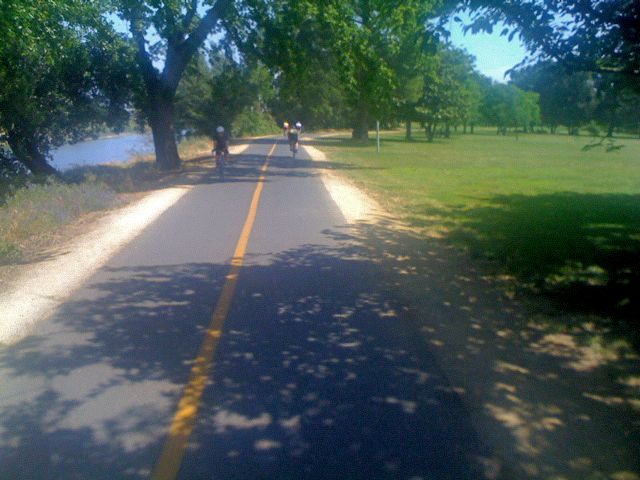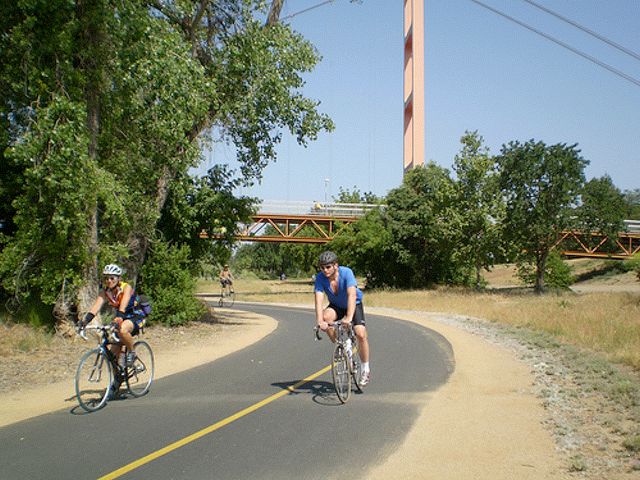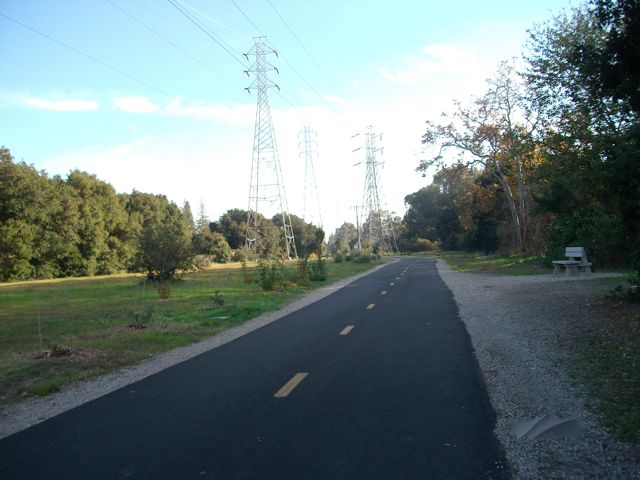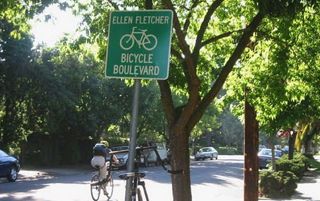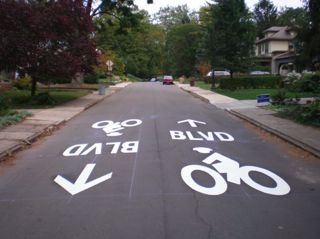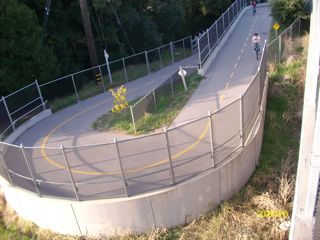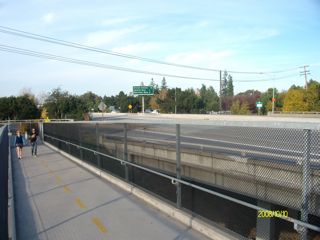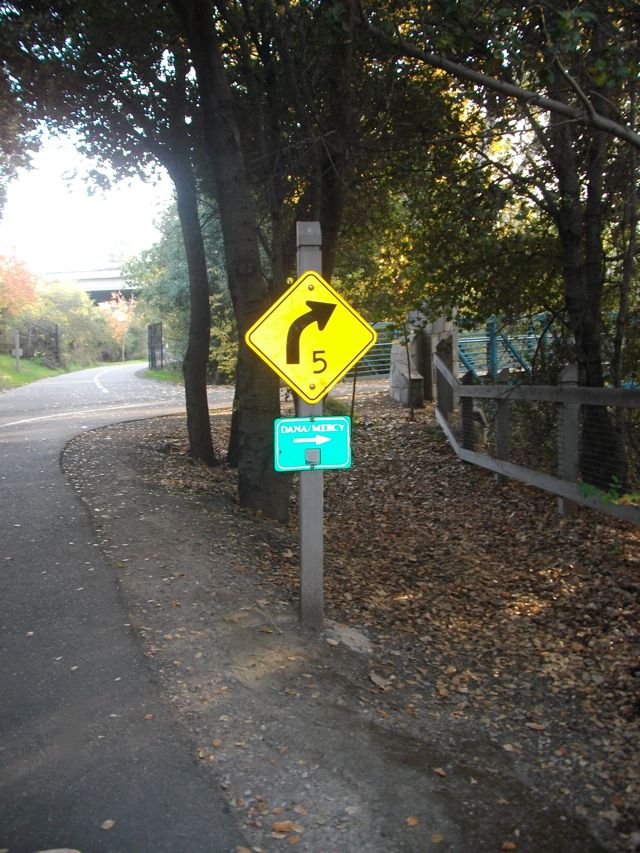Thirty years ago, Indy, as it is referred to by locals, offered nothing more than high speed roads on which shoulders were absent. In fact, the days of questions and map study that had led up it on my first ride across America, told me that the only way to get to the other side of Indianapolis, and the vast metropolitan area that it sat in the center of, was to go around it. In all, the detour that had resulted required an extra one hundred or so miles of travel.
Since 1990, however, much has changed. It was then that Indianapolis began its Greenway push with Ray Irvin. Once an Indianapolis councilman, and then the longtime Director of Indy Greenways, it wasn’t until 2008 when Irvin moved up to the state level in former Governor Mitch Daniels administration as the Director of Greenways and Bike Ways that Indianapolis knew what it had lost. In his easy, folksy way, Ray had kept everyone so busy, that most were blinded by the Greenway tidal wave he had them swept up in.
Through Indy Greenways (IG), the infrastructure Ray built for people power through several different Mayoral administrations, caused a whole new Indianapolis to emerge. So much so, that it is now a nationally respected leader in the Greenway universe.
Under Ray’s watch, with also the help of Indiana University, he had been able to document the rise in property values of those homes located in close proximity to IG's growing network of trails. This as the numbers of its users, even today, has not stopped growing. Many informal communities have also emerged in Indianapolis as people get out on to the IG pathways where they are no longer separated from one another by glass, plastic or metal.
Once a dying Rust Belt City, because of the still virile Indy Greenways that Ray has left behind, Indy has also witnessed a new vitality. It has become desirable to the class of people most American post industrial cities are just now realizing they need to attract in order to keep their economies growing. Called the Creative Class by noted author and economist, Richard Florida, this is the new generation of college graduates who work in high-tech businesses and knowledge intensive industries such as biotech, information technology and telecommunications.
Such workers are drawn to those cities where thinking is not walled in by the noise of freeways or traffic choked streets. In the same way large computer employers attract the best talent by turning their places of employment into college campus like settings with walking paths, fountains and lawns, Indy Greenways has been working hard to turn Indianapolis into one giant university grounds.
Indianapolis knew back in the ‘80’s, that in a part of the country where there was no ocean to hear or mountains to wonder at, that to attract the new blood of a virile work force, that its main attraction needed to be its beautiful green spaces. Toward this end, then, it had to get them interconnected as well as more accessible. The many miles of trails that resulted now reach 56 parks, 24 schools, a zoo, a stadium, museums and three arts and cultural districts.
Because IG also manages the bus lines and has a hand in bike travel in Indianapolis, its trail network is also inter-modal. In such a way, large employers, hospitals, libraries and most all-important destinations are all built into this exciting interconnected labyrinth. All of Indy’s buses and its 300 miles of signed on street bike routes interconnect with IG’s paved pathways making for a transportation system that functions quietly and efficiently in the background of a huge city at work.
The low cost travel network it has built enables its minimum wage earners to safely and efficiently get to their jobs at its restaurants, hotels, laundries, movie and sports complexes, and all those businesses that just make a city run as well as fun. While far from a perfect bike route system, many are still usually able to get to and from their work without getting caught up in the traffic on the streets.
By making it easy and affordable for its service industry workers to get around, Indy also knew that since a lot of these low paying positions are entry level jobs, that these people would keep using Greenways as they moved up in their positions. And already this is starting to pay off for Indy as these people graduate into their careers or move on to more responsible employment and even start to raise families.
Nor did any of this urban renewal require that Indianapolis decimate blighted neighborhoods or undertake any massive reconstruction projects. No, not at all. In fact the bulk of the recreation and transportation corridors that it built for its population came from the same stock of land many American cities already have at their disposal. Indianapolis created a lot of its linear parks by laying a small ribbon of asphalt on its once unused flood plains and abandoned rail corridors.
And it is here that Ray sees a way for other cities to build Greenways that can pay for themselves. He feels that underground utilities can be laid under them and that cities can charge a subterranean lease for this privilege. As such, digging up city streets every time a new gas, phone, sewer or cable line needs to be serviced would become a thing of the past
In making it desirable for people to get out of their cars in Indianapolis, so that he could begin building a Greenway consciousness, Ray had to fight against tradition. Founded as the state capital in 1821, Indy’s geographic presence in the center of the state has always made it a cross roads for travelers headed north to Chicago, south to Louisville, east to Cincinnati, or west to St. Louis. With the help of the Madison & Indianapolis Railroad, Indy’s population swelled from 8,000 in 1850 to more than 169,000 in 1900. By the time car travel pushed this number to 314,194 people in 1920, it rivaled Detroit for America’s top Motor City honors. In fact, the Duisenberg, Marmon, National, and Stutz all had their car factory headquarters there.
Indianapolis car culture became officially ingrained in the local consciousness in 1909 when 3.2 million bricks were used to build the world famous Indianapolis Motor Speedway. As we show you in the appendix when we discuss the Lincoln Highway, the racetrack was just one of former bike shop owner, Carl Fisher’s, many creations. The coast-to-coast road that he envisioned became a reality because he was able to call upon Indianapolis business leaders to build a nation wide momentum for his dream. Every year when its speedsters are in town and a great preponderance of city resources are dedicated to the racetrack, Indy keeps its place in the national consciousness as a city that takes its leadership from cars.
This despite the fact that in the 80’s Mayor William Hudnut set the city on a different track when he began the work of establishing Indianapolis as the Amateur Sports Capital of America. Aided by nearly 60 million dollars from the patriarch of the Lilly Endowment, Eli Lily himself, there were many projects that issued from Hudnut’s mandate. Besides the new tennis and swimming centers, track and field stadiums and the football coliseum that resulted, the world class Major Taylor velodrome also got built.
However in going from a dying car city once known as ‘Nap-town’ and ‘India-no-place’, the one project that most benefitted from the new image that Indianapolis firmly established for itself at the local level, was Indy Greenways. It is this organization that Ray drove for many years that continues to make it not only safe but also desirable to not be in a car in Indianapolis. So much so that communities from all over the country come to Indy Greenways for guidance on how to improve the quality of life in their cities - with Greenways!!
Nor is any of this awareness lost in Mayor Gregory Ballard’s Mayoral administration. In Indianapolis, Mayor Gregory Ballard was happily at the Depot, the replica of an Indiana train station that serves as Indy Greenway headquarters, to receive us.
A 64th Street trailhead, it is on the Monon Trail, a 10-mile work of Greenway art that Ray deserves to be proud of. The Monon was the first piece in the growing 165-mile Indianapolis greenway network, a network that has a 326-mile master plan. An abandoned rail track and once a blighted wasteland eyesore, overgrown with weeds, refuse and the occasional rusting automobile, the Monon has inspired a new renaissance in how the local Hoosiers relate to their lands.
Connecting a dozen residential neighborhoods with schools, parks, commercial districts and even the state fairgrounds, it is one of the busiest Car-Free pathways in the nation. Along the Monon, property values continue to far outpace those in the rest of the city as people find the adjacent housing to be some of the most desirable anywhere in Indianapolis. As the genuine community builder that it is, the countless informal neighborhood groups that use the Monon as an anchor, have made convivial exercise one of Indy’s predominant mantras.
While Ray has done a ton of work creating off-road infrastructure for his city, Mayor Ballard has moved mountains for those who ride his roads. In 2008, just as Ray was moving away from Indy Greenways, Ballard pushed the plan that developed the 200+ miles of bike lanes we were now able to enjoy. He also led the charge that resulted in a Mayor’s Bicycle Advisory Council and his city hired its first Bike/Ped coordinator.
Under Ballard’s reign, the Indianapolis Cultural Trail that Ray long had as a work in progress, quickly steamrolled into place. It connects cyclists with many areas of downtown Indianapolis. In seeing that their needs now had an ally in high office, IndyCOG, the local bicycle advocacy group, among other actions, created a cutting edge bicycle map for the city.
In taking its lead from Ballard, the private sector is also teaming up with the city in joining the bicycle explosion that is taking place in Indy. The Indy Bike Hub YMCA, for example, was completed in the Fall of 2011. It houses secure bicycle parking for 148 bikes, a fitness center, lockers/showers, a bike shop, bicycle advocacy organization offices and the city's bicycle patrol unit.
The group of men and women we rolled up to, were all dressed in suits and other office wear. In addition to Mayor Ballard and his staff, there were others there that were known as local Greenway shakers and movers. Familiar faces, I had worked with many of them over the years. Joseph Wynns, the director of Indianapolis Recreation, of which Indy Greenways is a part, was there. As was Ron Carter the Indy Greenways director who replaced Ray when he moved on to the state level. Even John Glick, the man who talked with me about his fixed gear bicycle rides to work as far back as 2002, was there also on behalf of the recreation department.
The others we had no way of knowing, moved their Greenway mountains behind the scenes. There were officials from firms who had done construction work on Indy Greenway trails as well as from Indiana State University. The college continues to supply Indy Greenways with the mountains of data they use to procure added funding for their trail building efforts. In a city driven by the needs of its Greenway, members of the Indianapolis Greenways Development Committee, a 15-person volunteer board of directors assigned to their positions by the Mayor, Council and the Recreation Board, were there. A representative from the Greenways Foundation, the charitable trust which finances the Indy Greenways operation gave added authority to our reception.
Ron Carter was all smiles as we rolled up to the group that had assembled.
“Martin,” Ron called. “You made it!”
Instantly though we’d never met in person, I know who he was from all the talking we had done on the phone as he and I organized this event.
“Wow Ron,” I said as I worked my way off the bike to the amazement of most everyone present.
“So that’s how you do it. I was wondering how you were going to get off that thing,” Ron said.
“Getting off is a skill just like getting on,” I replied. “And it looks like you’ve got a few Greenway friends!” I was happily impressed
“Well I figured you were worth it,” he joked. Pointing he continued, “Now why don’t you bring you and your team over here so we can get everyone introduced to our Mayor.
The 48th Mayor of Indianapolis, Gregory Ballard and I both graduated from Catholic high schools and then college at about the same time. However while I was busy recovering from a head injury and just trying to get to the starting line of a life where I could be productive, Ballard saw the world during his 23-year career in the Marines. A tall and strong looking man, the force of his character was apparent when he looked me in the eyes and said, “So Ron tells me you want to do what we’ve done here with our Greenways all across the US. From San Francisco to Washington, DC,” as he shook my hand.
“You’ve got it Mayor Ballard. That’s why we’re visiting you on this ride.”
As the two of us exchanged pleasantries, the media pressed closer with their cameras and notepads.
"So are you going to DC to call attention to some kind of Carl Fisher bike path you want to build from here to San Francisco?" a voice wanted to know.
"Whoaa, what newspaper are you with?" I asked.
"The Indianapolis Herald," his reply was matter of fact.
"I should make your talk to your book review editor then," I teased. "She asked me the same question when she was getting a story together about tonight's booksigning."
Seeing that he was too busy taking notes to react, I was happy that he had given me this opening, "So like I told her, and I am sorry I can't remember her name, it is not a bike path but a coast to coast network of bikeable roads and paths that will connect cyclists to cities and the important destinations within those cities. And in time some of that will give way to a dedicated arterial for bikes but we gotta make it so cars and bikes can safely coexist in as many places as we can."
"In terms of strategy, we have determined that the best way to build this consciousness is to follow the same precedent that Carl Fisher’s Lincoln Highway set all the way back in 1913. As America's first coast-to-coast highway, it started out as a red line on the map. In his boldness, your native son prescribed a route from Washington DC to San Francisco back when most of the roads west of the Mississippi were no more than ruts in the weeds.
"And as they struggled to get it built, other roads and highways sprang up all over the nation. In time, the Lincoln disappeared into the numbered US highway system, much of which was then usurped by the I-80 that we know today. The example they set, however, is how I foresee us going forward. We're asking for a coast to bicycle highway at a time when dedicated bikeways are far and few between. And just as the people of the early 1900's thought that roads that extended beyond the city were only for the rich hobbyists of the day, we will be showing how we can rebuild America by connecting cyclists to its cities and all the important place within them.
"So just like Carl Fisher and Henry Joy did with their Lincoln Highway, that I show in the appendix of my book, we are going to keep promoting the San Francisco to Washington DC Mayors' Ride route. Heck after Fisher formalized his route with his 1913 cross-country trip, after World War I, they even got the US Army to take a convoy across the US on it as a kind of a victory march.
“Instead of sending 72 vehicles, most of them heavy military trucks, across America to rally a sense of patriotism like they did, we will keep sending every day bike riders and not racer celebrities, to meet Mayors. All of this will get people more and more excited about reconnecting to their health, one another and to themselves with the Greenway we foresee."
Seeing that they were busy taking notes, I announced, “OK, so let’s get everyone together for a group photo. I know most of you are hammered for time so let’s get rocking with this.” Pointing I continued, “I say we all stand here”.
I walked up to Mayor Gregory and joked, “Mayor Greg we’re gonna make you the star today. Is that OK?”
He smiled back at me as I pressed on with my choreography, “Can we get all of you standing here to move closer to the front?”
I kept nudging and coddling until I had everyone in place. Soon, one of the Mayor’s staffers was snapping pictures. By the time Indianapolis NBG Day was complete, there were probably twenty of us celebrating the proclamation Mayor Ballard had prepared for us.
The rest of the day, as Ron and I compared notes and took a closer look at some of his pathway projects, I began to realize something about what I was experiencing. If other cities put more of their people to work studying and building Greenways as well as using them and enjoying the enhanced quality of life they bring as they also grow richer at the bank, that they would all try to be like one another. That was how a coast-to-coast Greenway network was going to become real.
I knew I had work to do. I had to get the Indy Greenway story out there. Already I was starting to get ready for our next stop, Cincinnati.

